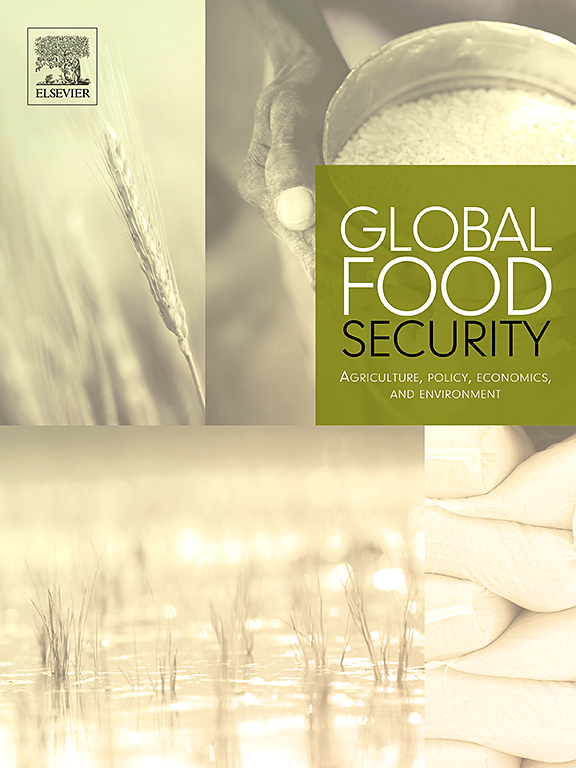城市化在整个农村-城市连续体中塑造了西非的饮食
IF 9.8
1区 经济学
Q1 FOOD SCIENCE & TECHNOLOGY
Global Food Security-Agriculture Policy Economics and Environment
Pub Date : 2025-05-23
DOI:10.1016/j.gfs.2025.100858
引用次数: 0
摘要
由于缺乏对“城市”区域的统一定义,我们对城市化如何与食品消费相互作用的理解受到了阻碍。使用二元命名也未能捕捉住区类型的复杂性和多样性,并导致对“城乡差距”的关注。本研究结合了八个西非国家具有全国代表性的家庭食品消费调查数据,以及根据城市化程度的全球定义获取城市化梯度的地理空间数据。这使我们能够分析城乡连续体中不同食物组的消费、饮食质量和宏量营养素摄入量。我们发现了强有力的证据,表明食品消费总量的城乡梯度越来越大,人们逐渐从传统的主食转向消费更少或不需要加工的食品。居住在城市化程度较高的地区,饮食更多样化,蔬菜和动物源性食品的消费量增加。然而,不健康食品和脂肪摄入量的增加,特别是在农村-城市连续体中,导致饮食质量恶化。虽然估计的影响在城市中最为强烈,但这些饮食转变也发生在城郊地区和农村地区。这证实了在与粮食消费有关的研究和政策中超越简单的城乡二分法的重要性。在整个农村-城市连续统一体中,离家吃饭的重要性已得到证明,这进一步强调了需要进行更多的研究,以更好地了解这一部门,并探索它如何促进就业和粮食安全。本文章由计算机程序翻译,如有差异,请以英文原文为准。
Urbanization shapes West African diets throughout the rural-urban continuum
Our understanding of how urbanization interacts with food consumption has been hindered by the lack of a unified definition of what constitutes an “urban” area. The use of a binary designation also fails to capture the complexity and diversity of settlement types and results in a focus on the “rural-urban divide”. This study combines nationally representative survey data on household food consumption from eight West African countries with geospatial data capturing the urbanization gradient following the global definition of the Degree or Urbanization. This allows us to analyse consumption of different food groups, diet quality, and macronutrient intakes throughout the rural-urban continuum. We find robust evidence of an increasing rural-urban gradient in total food consumption, as well as a gradual shift away from traditional staple foods, towards increased consumption of foods that require less or no preparation. Residing in more urbanized areas is associated with greater diet diversity and increased consumption of vegetables and animal-source foods. Yet, rising intakes of unhealthy foods and fats in particular along the rural-urban continuum contribute to a deterioration of diet quality. While the estimated effects are strongest in cities, these diet transitions also take place in peri-urban areas and rural areas. This confirms the importance of moving beyond a simple rural-urban dichotomy in research and policy related to food consumption. The demonstrated importance of foods eaten away from home across the entire rural-urban continuum further underscores the need for more research to better understand this sector and explore how it can contribute to both employment and food security.
求助全文
通过发布文献求助,成功后即可免费获取论文全文。
去求助
来源期刊

Global Food Security-Agriculture Policy Economics and Environment
FOOD SCIENCE & TECHNOLOGY-
CiteScore
20.90
自引率
3.40%
发文量
69
期刊介绍:
Global Food Security plays a vital role in addressing food security challenges from local to global levels. To secure food systems, it emphasizes multifaceted actions considering technological, biophysical, institutional, economic, social, and political factors. The goal is to foster food systems that meet nutritional needs, preserve the environment, support livelihoods, tackle climate change, and diminish inequalities. This journal serves as a platform for researchers, policymakers, and practitioners to access and engage with recent, diverse research and perspectives on achieving sustainable food security globally. It aspires to be an internationally recognized resource presenting cutting-edge insights in an accessible manner to a broad audience.
 求助内容:
求助内容: 应助结果提醒方式:
应助结果提醒方式:


